9 Species of Woodpeckers in New Hampshire (with Pictures)
Last Updated on
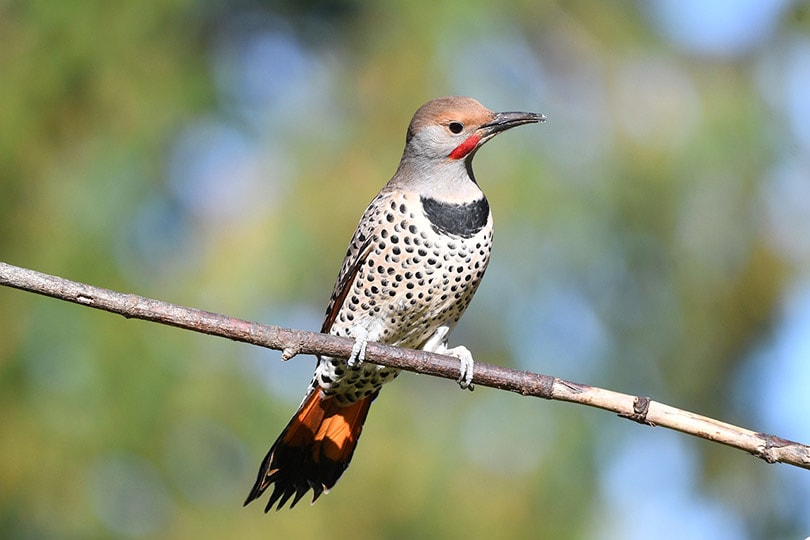
Even though New Hampshire is one of the smaller states in the US, it is considered the second-most forested state in the entire nation, with over 4.8 million acres of forest. Because of how much forest area there is, there’s no shock that New Hampshire is home to woodpeckers.
In fact, New Hampshire is home to eight native woodpecker species, and there is an additional ninth species that sometimes comes in the winter. Being able to identify these different woodpecker species can make your New Hampshire outings more fun.
Below, learn about nine species of woodpeckers in New Hampshire.

The 9 Species of Woodpeckers in New Hampshire
1. Downy Woodpecker

| Length | 5.5–7 inches |
| Weight | 0.7–1.2 ounces |
| Wingspan | 10–12 inches |
One of the most common woodpeckers in New Hampshire is the Downy Woodpecker. Downy Woodpeckers are known for being friendly and a bit courageous. In comparison to other woodpecker species, Downies frequent backyard feeders much more frequently than others.
Downy woodpeckers are also pretty easy to identify. They are small and almost look like sparrows. The wings have black and white patterns with white patches down the middle. The males also have a red patch on the back of their heads. Downy woodpeckers are most often confused for Hairy Woodpeckers.
2. Hairy Woodpecker
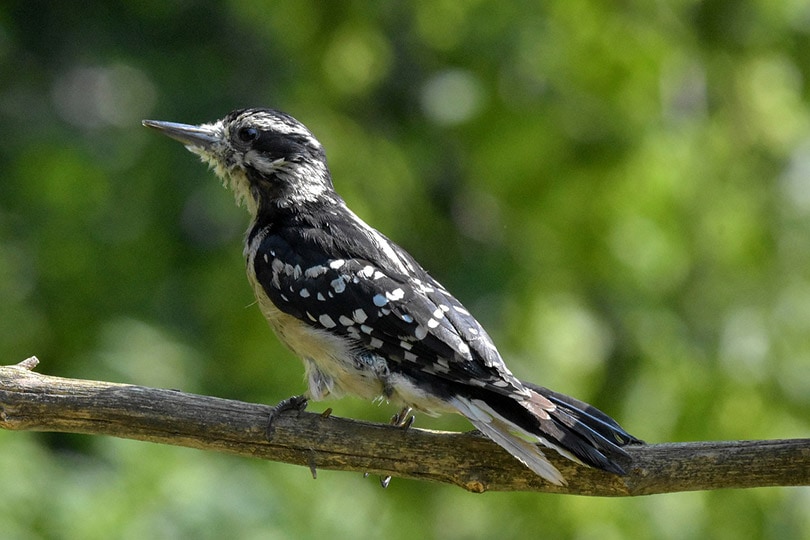
| Length | 9–13 inches |
| Weight | 1.5–3.5 inches |
| Wingspan | 13–17 inches |
Hairy Woodpeckers look a lot like Downy Woodpeckers because they have the same color pattern, and the males even have red patches. However, Hairy Woodpeckers are quite a bit bigger than Downy Woodpeckers. In fact, Hairy Woodpeckers are typically twice as big as the Downy.
Hairy Woodpeckers are also very friendly. You can find them at backyard bird feeders, but they aren’t quite as social as other woodpeckers and birds. For this reason, they are more likely to forage on their own.
3. Red-Bellied Woodpecker
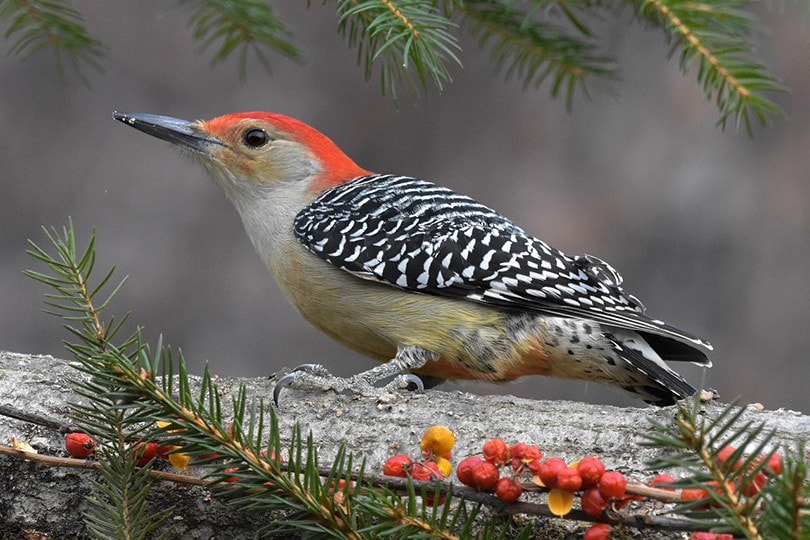
| Length | 9–10.5 inches |
| Weight | 2–3 ounces |
| Wingspan | 15–18 inches |
The Red-Bellied woodpecker has a misleading name. Its belly is actually white and has some reddish spots, but it is primarily pale. The head, however, has a bright red coloration, though its appearance is distinct from the Red-Headed Woodpecker, which we will discuss below.
During the winter, Red-Bellied Woodpeckers are likely to migrate south. As a result, these birds are very common around the eastern United States. You can easily find these woodpeckers at home bird feeders.
4. Red-Headed Woodpecker
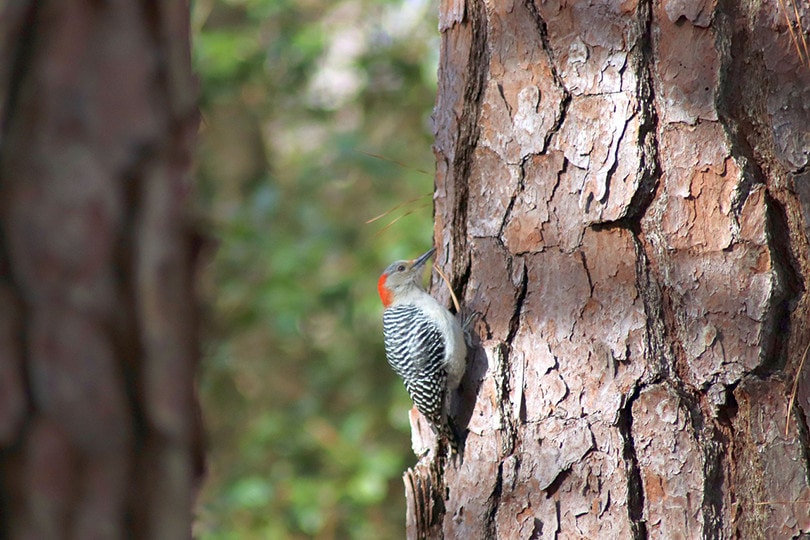
| Length | 7.5–10 inches |
| Weight | 2–3.5 ounces |
| Wingspan | 16–17 inches |
The name of this bird says it all. Red-Headed Woodpeckers have striking red heads. The rest of the body is white and black, and their underparts are white. For the top of the body, the tops of the wings are black, but the bottoms are white.
You’re most likely to see a Red-Headed Woodpecker during the summer. During the winter months, they often migrate south so that they can find warmer environments.
5. Pileated Woodpecker
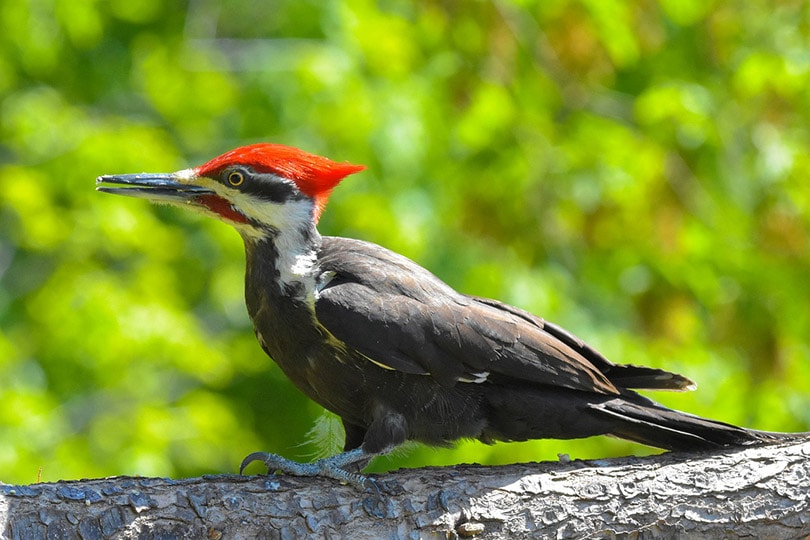
| Length | 16–19 inches |
| Weight | 9–14 ounces |
| Wingspan | 26–30 inches |
The Pileated Woodpecker is the largest woodpecker species in all of North America. They have prominent red crests. Supposedly, the Pileated Woodpecker is what inspired the creation of Woody Woodpecker.
Even though Pileated Woodpeckers are very common in New Hampshire, you will have to look a lot harder to find them. These birds stay in dense forests and often thrive in mature forests that have dead trees and fallen logs.
6. Northern Flicker

| Length | 11–14 inches |
| Weight | 3–6 ounces |
| Wingspan | 17–21 inches |
The Northern Flicker is mainly brown, which is a unique coloration for woodpeckers. In addition to the brown coloration, there are crescent-shaped black patches under the bird’s neck. Its wing also has yellow highlights and a red patch over its nape.
The Northern Flicker is different from other woodpeckers because it actually prefers to forage on the ground to find ants and beetles. They are willing to eat from backyard feeders. Whenever they do find themselves in an area with humans, they often form relationships with them because these birds can live up to 6 years.
7. Yellow-Bellied Sapsucker

| Length | 7.5–8.5 inches |
| Weight | 1.5–2 ounces |
| Wingspan | 13.5–16 inches |
Yellow-Bellied Sapsuckers have a belly with a yellowish-white tint. Even though yellow is often easy to spot on birds, that isn’t always the case for the Yellow-Bellied Sapsucker. On the contrary, its red head is easier to spot.
To make spotting these birds even more difficult, they aren’t always out and about. You’re most likely to find them in the spring when it’s the breeding season. During the winter, they migrate south.
8. American Three-Toed Woodpecker

| Length | 7.5–8.5 inches |
| Weight | 2–2.5 ounces |
| Wingspan | 14–15 inches |
The American Three-Toed Woodpecker is a relatively common woodpecker species, but they are difficult to identify. They only have three toes, but it is often difficult to get close enough to the bird to see this.
The American Three-Toed Woodpecker is endangered in New Hampshire. It also is mostly found in Canada, despite its name. You will mainly only find this bird in the northern parts of New Hampshire, such as around the White Mountains.
9. Black-Backed Woodpecker
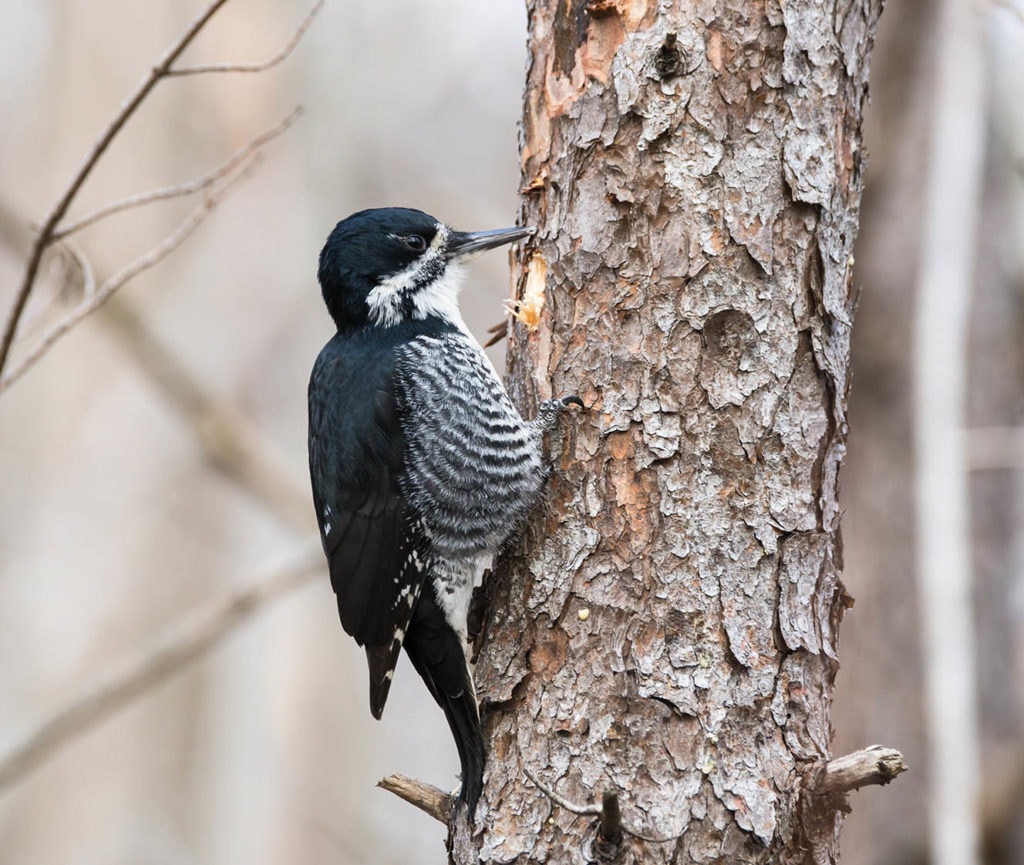
| Length | 7.5–8.5 inches |
| Weight | 2–2.5 ounces |
| Wingspan | 14–15 inches |
The last woodpecker on our list is the Black-Backed Woodpecker. This bird is actually native to Canada and parts of Alaska, but it can sometimes be found in New Hampshire during the winter months.
This woodpecker is related to the American Three-Toed species. They have a similar black and white color scheme as a result. This woodpecker has a more dominant behavior and caws louder.

How to Attract New Hampshire Woodpeckers
If you want to attract woodpeckers to your New Hampshire yard, it’s important that you attract them with the right snacks and treats. If you set up your yard appropriately, woodpeckers can become as common as sparrows and chickadees. Here are some tips to incorporate around your yard:
- Use suet feeders with black sunflower seeds.
- Do not remove dead trees from your area.
- Erect nest boxes. Many woodpeckers use nest boxes from spring all the way to July.
- Plant native, fruit-bearing plants, such as mountain ash, strawberry, blueberries, mulberries, and elderberries.
- Erect a battery-powered water source that moves the water. Woodpeckers prefer to bathe in moving water.

In Conclusion
If you live in New Hampshire, you are in luck. There are plenty of woodpeckers flying around the dense forest areas, no matter the season. At any one time, you are liable to see one of the nine woodpecker species above.
To attract more woodpeckers to your area, make sure to set up feeders, plants, and water that the woodpeckers enjoy. Additionally, select a moving water source to keep woodpeckers hydrated and clean.
Featured Image Credit: Veronika_Andrews, Pixabay
About the Author Robert Sparks
Robert’s obsession with all things optical started early in life, when his optician father would bring home prototypes for Robert to play with. Nowadays, Robert is dedicated to helping others find the right optics for their needs. His hobbies include astronomy, astrophysics, and model building. Originally from Newark, NJ, he resides in Santa Fe, New Mexico, where the nighttime skies are filled with glittering stars.
Related Articles:
Monocular vs Telescope: Differences Explained (With Pictures)
10 Types of Hummingbirds in Arkansas (With Pictures)
8 Types of Hummingbirds in Nebraska (With Pictures)
5 Types of Hummingbirds in Idaho (With Pictures)
3 Types of Hummingbirds in Mississippi (With Pictures)
8 Types of Hummingbirds in Kansas (With Pictures)
5 Types of Hummingbirds in West Virginia (With Pictures)
5 Types of Hummingbirds in Ohio (With Pictures)
